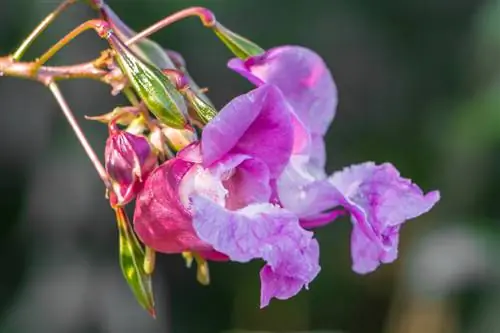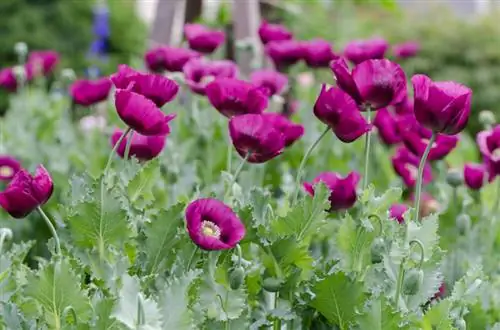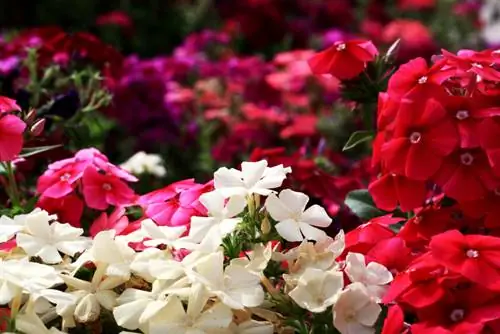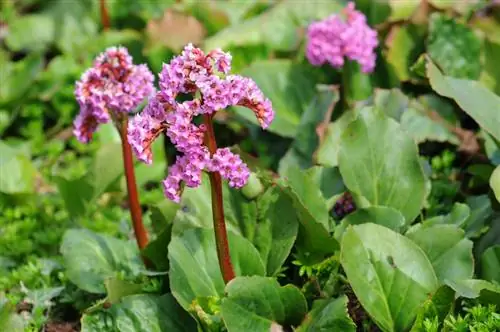- Author admin [email protected].
- Public 2023-12-25 17:45.
- Last modified 2025-01-23 11:22.
With their cheerful, colorful splendor, impatiens create summery flower symphonies in the bed and on the balcony. Just a little gardening attention is enough for the busy lizard and other decorative jewelweeds to thrive. The answers to frequently asked questions convey what is really important in cultivation.
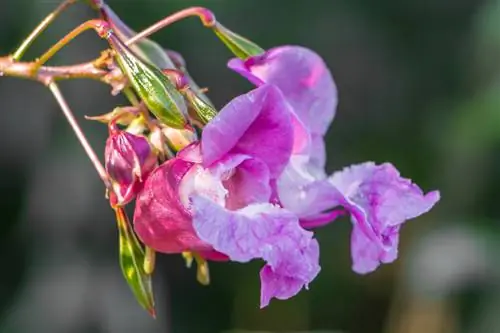
What are important care tips for jewelweed?
Jerseyweeds, also called impatiens, are colorful flowers that thrive particularly in partially shaded locations and moist soils. They bloom from May until the first frost and some species, such as the Busy Lieschen, can also be cultivated as houseplants.
Planting spring herbs correctly
When Cold Sophie retires as the last ice saint in mid-May, she opens the time window for the planting of impatiens. Choose a partially shaded, protected location with humus and deep, loose soil. An acidic pH value of 5.5 to 6.8 is of utmost importance. Make small pits at a distance of 20-25 cm in the finely crumbly prepared soil. Follow these steps:
- Enrich the excavation with rhododendron soil, compost and horn meal
- Place potted impatiens in lime-free water until no more air bubbles appear
- Unpot the soaked root balls and plant down to the lower pair of leaves
Last but not least, press the soil with your hands and water generously without causing waterlogging. In this sequence, you plant impatiens in pots and balcony boxes with rhododendron or ericaceous soil as a substrate. Additionally, add some pottery shards above the water drain as effective drainage against waterlogging.
Care tips
If the care protocol is dominated by consistency, the plant will work tirelessly with vital growth and an abundance of flowers. The following aspects are important:
- Keep the substrate slightly moist with decalcified water
- Fertilize organically in the bed every 4 weeks, in the planter every 2 weeks
- Clean out wilted and faded things regularly
- Fill coasters with water and pebbles to create higher humidity
Place impatiens on the balcony in good time before the first frost. The winter quarters are flooded with light, with minimum temperatures between 12 and 16 degrees. Cut back and repot overwintered plants in spring.
Which location is suitable?
The tropical plant feels at home in a partially shaded location. Wherever the blazing midday sun cannot reach, the colorful impatiens decorate the picture. Ideally, temperatures of 18 to 24 degrees Celsius prevail during the growth and flowering period, in combination with high humidity of 60 to 75 percent.
What soil does the plant need?
For impatiens to spread a tropical, opulent flair, the soil should be like this:
- Nutritious, humic and well-drained
- Fresh-moist to sandy-loamy
- An acidic pH of 5.5 to 6.8
Common potting soil does not meet the requirements for pot cultivation. Experienced hobby gardeners prefer to mix it themselves. A good substrate for impatiens, for example, is composed like this: 3 parts peat, 2 parts potting soil, 1.5 parts clay, 0.5 parts quartz sand and 1 part lava granules. You can either use high-quality rhododendron or ericaceous soil, optimized with expanded clay.
What is the best time to plant?
The annual impatiens are sensitive to frost. As a result, the planting time in the garden does not begin until mid-May at the earliest, when the Ice Saints have said goodbye. There is nothing wrong with planting in pots and balcony boxes from April onwards, as long as it is guaranteed that the sensitive plant can spend the cold nights behind glass.
When is flowering time?
The tropical plant spoils us with its heavenly abundance of flowers from May until the first frost. Although impatiens are naturally designed as evergreen, perennial ornamental plants, temperatures below zero degrees mercilessly put an end to the flower festival. Cultivated as a houseplant, the flowers in the right location will not fail throughout the year.
cut spring herbs correctly
Pruning plays an important role in the professional care of impatiens. To ensure that withered flowers do not affect the aesthetic appearance, they are cut out regularly. In this way, the vehement seeding in the bed is effectively prevented. At the end of the flowering period, cut the plant close to the ground or dig up the annual flower. Since busy lizards can overwinter as houseplants, in this case the plant is cut back by up to two thirds in early spring. The shoots then sprout again for another season full of flowers.
Watering spring herbs
It is no coincidence that Swiss hobby gardeners affectionately call the busy Lieschen Süüfferli because it is constantly thirsty for water. This high water requirement is what characterizes all Impatiens species. Therefore, water regularly and abundantly without causing waterlogging. Ideally, you should use decalcified tap water or collected rainwater administered from below. Overhead irrigation always carries the risk of rot and fungal infections.
Fertilize spring herbs properly
In the bed, from May until the end of the flowering period, adding compost and horn meal every 4 weeks covers the nutrient requirements. In the limited substrate volume of the planter, we recommend applying liquid fertilizer for flowering plants for 14 days. Alternatively, apply a slow-release fertilizer in May and refresh it in July.
Wintering
Native to the tropical and subtropical regions of the world, the plant becomes limp at temperatures below 10 degrees Celsius. The only option that can be considered in the open air is annual cultivation. Balcony and house plants have the possibility of he althy overwintering in pots under the following conditions:
- Bright location with temperatures between 12 and 16 degrees Celsius
- Pour adapted to the conditions
- Fertilize liquid every 6-8 weeks
From May onwards, the plant returns to its original position and immediately starts producing fresh shoots.
Propagate spring herbs
As a lush, continuous bloomer for low-light locations, the plant awakens the desire for more specimens. It's good to know that every pruning during the growing season provides plenty of material for propagation. Breeding pure varieties is achieved using cuttings like this:
- Defoliate non-flowering head cuttings with a length of 10-15 cm in the lower half
- Place in 9 cm pots filled with lean, acidic potting soil
- Put on a transparent hood and place it in the partially shaded window seat
- Water regularly from below
After 3-4 weeks, a vital root system has developed so that the young impatiens can be repotted into full-fledged substrate.
Is jewelweed poisonous?
All Impatiens species are mildly poisonous plants. The toxicity refers to the leaves and stems, while flowers and seeds are suitable for consumption. Thanks to their high nectar content, the delicate flowers are a delicious treat, which is in no way inferior to the nutty seeds in autumn. However, caution should be exercised when it comes to the leaves, as consuming large quantities can cause severe nausea and vomiting.read more
Brown leaves
If the lush green leaves on Impatiens turn brown, check the site conditions and the water supply. If there are brown spots that are constantly spreading, the plant is suffering from sunburn. After moving to a partially shaded location, the flower will recover. Consistently brown leaves usually signal drought stress. Remove the dried leaves and water frequently so that the root ball remains constantly moist.
Yellow leaves
Yellow leaves streaked with green veins are a classic symptom of leaf chlorosis. The plant suffers from an excess of lime because hard tap water is used for watering. Water impatiens consistently with soft water to prevent this dilemma.
How do I care for impatiens as a houseplant?
Equipped with the potential for perennial cultivation, magnificent varieties are ideal as evergreen and ever-flowering houseplants. If the location consistently offers at least 1,800 lux of light, the flowers will never run out of steam. How to properly care for the plant on the windowsill:
- If the substrate dries, water it generously with decalcified water
- Tip out any excess water from the saucer after 10 minutes at the latest
- Winter from October to February at 12 to 16 degrees Celsius in a bright window seat
- Fertilize liquidly every 14 days from March to September and every 6 weeks from October to February
- In spring, cut back the plant vigorously and repot it
To meet the desire for high humidity, fill the coaster with pebbles and water. The rising steam surrounds the plant and creates a tropical microclimate.
How can jewelweed be successfully combated as a weed?
Harried hobby gardeners consider the glandular balsam (Impatiens glandulifera) to be the dark sister of the busy lady. This plant spreads explosively in the garden through seed and is therefore classified as a neophyte. In order to effectively combat weeds, the following aspects must be taken into account:
- Start pulling out the plant consistently in spring
- Mow larger areas repeatedly or cut with a scythe
- If the infestation is persistent, cover the bed with black foil for one season
- Never dispose of clippings in the compost, but instead in the household waste
The main premise for a successful control strategy is not to let the plant go to seed under any circumstances. Glandular jewelweed throws its seeds up to 7 meters to conquer your green kingdom. The use of herbicides is not recommended as the poison has a widespread effect and affects other plants.read more
Beautiful varieties
- Fiesta Sparkler Hot Pink: Double double flowers in pink and white, reminiscent of small roses; Growth height 25-40 cm
- Busy Lizzy: Gorgeous hybrid with camellia-like, double flowers in salmon pink and white; Growth height up to 40 cm
- Costa Rica Lieschen: A whole series of profusely blooming impatiens in furious colors; Growth height 25-40 cm
- Petticoat White: Noble lilies with white flowers and ruffled edges, ideal for the pot; Growth height 25-30 cm
- Strawberry Twist: Premium variety Impatiens Cameo with pink-white, bulging flowers; Growth height up to 40 cm
- Balfour's Balsam: Dainty plant with two-tone flowers in purple-white with a strong urge to spread
- Rührmichnichtan: Large jewelweed with bright yellow flowers and spectacular fruits; Growth height up to 100 cm

